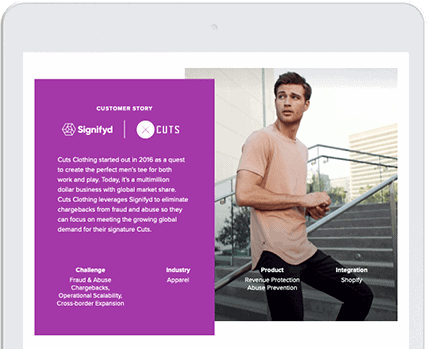When Steven Borrelli was working for other people, there were two things he knew he wanted to do: start a successful business of his own and find a well-designed, high-quality T-shirt that he could wear with equal ease to work or play.
And so, Cuts Clothing.
OK, so business success stories are never that easy. But at its core, Cuts is a labor of love infused with ample entrepreneurial spirit.
“I wanted to see if I could create a million-dollar business at the time,” Borrelli says of the months leading up to Cuts 2016 launch. “I wanted to be a part of a team that had a vision that stayed the same, that year over year, I was working toward a mission.”
Check. Check. And check. Today California-based Cuts is a multimillion-dollar business, selling stylish, casual clothes for men that acknowledge the different sizes, shapes and preferences that make us individuals.
- Steve Borrelli was inspired by a fashion need and his entrepreneurial spirit to launch a clothing line meant for men on the go.
- The idea was a good one — so good that Cuts experienced massive growth, posing some challenges.
- Borrelli and team turned to apparel and order automation to allow Cuts to scale up a the same pace the clothing line’s popularity was growing.
Cuts makes clothing for the sport of business, Borrelli likes to say. Find your shirt, pick your color, select your cut — classic, elongated, split. The brand displays the sort of simplicity and empathy that epitomizes the direct-to-consumer wave that has seized consumers’ imaginations.
“We are specifically ecommerce and we’ve really grown through doing one product really great,” Borrelli says. “We offer a different way to shop shirts, which I’m really proud of.”
T-shirts to Henleys to polos to hoodies to hats
The brand expanded from T-shirts to Henleys to polos to hoodies to hats — and even to face coverings. In the COVID era, Borrelli explains, masks are the new socks. Sometimes, you’ve just got to change it up.
“You’ve got to have a lot of masks,” Borrelli says of the 2020 everyday accessory. “One branded, one not branded. We do like a handkerchief/bandana. It’s something we’ve done well with.”
So, yes. Cuts is growing. Besides the United States, the brand sells into Canada, Australia, Europe and Hong Kong. It plans to open distribution centers overseas soon.
And with that growth came issues of scaling, including when it came to reviewing online orders for fraud and protecting the business from false claims that something went wrong with an online order.
Cuts started by doing its own fraud reviews, as many businesses do. But as the number of orders increased (a good thing), the time the Cuts crew spent reviewing orders increased too (a bad thing).
Manual fraud review and a growing business don’t mix
“It was almost a full-time job in terms of hours,” Borrelli says.
Even deciding which orders to review and what to base a ship-or-don’t-ship decision on became unmanageable.
“We would try to do the eyeball test and that never works,” he says. “We were just spending so much time.”
He and his vice president of finance, Carter Shea, would flag the biggest orders, because they presented the potential for the greatest loss. But, of course, big orders also represented the most valuable customers.
“It was a we-would-just-mess-up-our-best-customers type of deal,” Borrelli says. “We definitely blew it and some people were furious.”
It was devastating, especially for a team that prided itself on bonding and building relationships with customers.
And besides devastating, the DIY fraud review was also expensive, as the best fraudsters are hard to detect. How expensive?
“It was significant. It was in the tens of thousands,” Borrelli says. “And I think the biggest thing is when you don’t have any kind of protection or safeguards, you’re an easy target. There are so many bad people out there that would just tell the criminals, “Go hit them.’”
Automated fraud and abuse management frees a business to scale at will
And so, Borrelli turned to Signifyd’s Commerce Protection Platform. He and his team liked the idea that Signifyd combines machine learning and big data from its Commerce Network of thousands of merchants to instantly sort fraudulent and legitimate orders. The system automated Cuts order flow and was infinitely scalable.
They liked the platform’s Abuse Prevention solution, which automates the management of non-fraud chargebacks and extends Signifyd’s payment-fraud financial guarantee to all manner of chargebacks.
Abuse Prevention also ensured more precise decisions on which non-fraud chargebacks Cuts should be contesting and which might be based on a legitimate misunderstanding. It was a way, in other words, to avoid unnecessarily insulting good customers.
“You guys are proactive, versus internally, we would have only been able to be reactive,” Borrelli says. “There is no way we could do it in-house because we don’t have the relationships with other brands that you guys do and that domain experience is something that is saving us money.”
With concerns about fraud and abuse chargebacks off their plates and with the time it took to manage that back in their schedules, the Cuts team members are looking ahead. The future could bring some form of physical retail and a women’s line.
But being a true digitally native brand, Cuts isn’t looking to replicate the retail experience of past decades or even last year.
A Cuts shop won’t be your parents’ apparel store
“We’re really excited about (physical) retail,” Borrelli says. “But more experiential than transactional.”
A Cuts shop would be a place to meet with customers, to get to know them. Maybe customers would stop in for a free LinkedIn portrait or a cup of coffee. Or maybe they’d want free hemming on a shirt or fashion advice.
Or maybe they’d stop by for business advice.
“I love the pursuit of doing something big and wanting to create something big,” Borrelli says. “We’re so much more than just a T-shirt brand. We’re a group of individuals that want to create a billion-dollar brand one day and make an impact and share our story of how we did it.”
Judging from the first few chapters, you can bet that that story is going to be a page-turner.
Need help with rapid ecommerce growth? We’re here for you.











